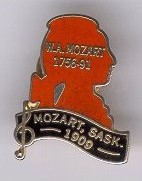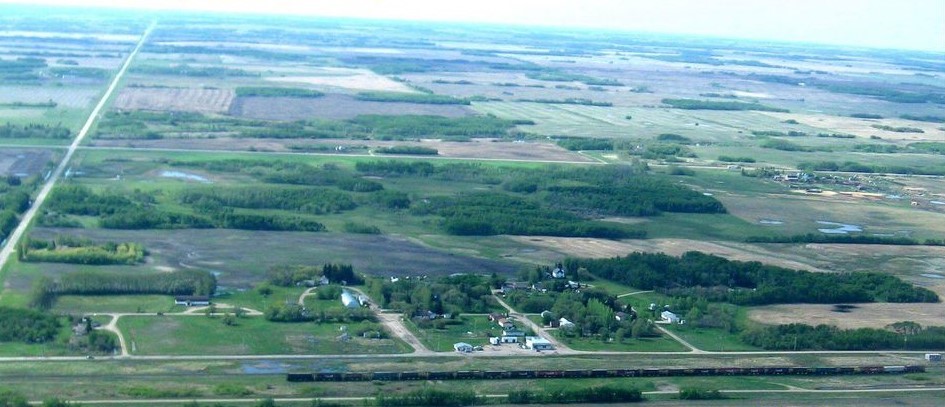
The Mozart pin
In 1909, when Canadian Pacific Railway (C.P.R.). engineers were planning the railway from Elfros to Mozart, they stayed on the Lund farm. They were so impressed with the food and lodging that they asked the housewife, Julia Lund, to name the townsite. She suggested Mozart after Johan Wolfgang Mozart, the Austrian composer.
First Icelanders: Jón Sigurðsson Laxdal from Húnavatnssýsla was one of the first settlers in the district. He had been living on his homestead near Morden, Manitoba for four years but in 1903 he bought land west of Elfros. Four comrades of his in Morden gave him permission to use their homestead rights in the Mozart district and select land for each of them. They were Jónas Tómasson, Jóhann Pálsson and two brothers, Jón Egill Ágústsson and Axel Ágústsson, all from Eyjafjarðarsýsla. J. S. Laxdal complied and in the spring of 1904, Jónas, Jón Egill, and Axel travelled north with four work oxen and began work on their lands. Friðrik Guðmundsson wrote the first part of the History of the Vatnabyggð settlements, and was published in the Almanak in Winnipeg in 1917. This is what he wrote on these four pioneers: “They started by building four log cabins, one on each homestead and then broke some land on each farm. In the fall, they headed east to work on the harvesting”. East means Morden, Manitoba where they remained during the winter as Friðrik explains in his article: “In the early months of 1905 they began planning their move northwest. Jóhann Pálsson now determined to go with them but that was not to be, he passed away during the winter. His father in Iceland was notified and asked how he wanted Jóhann´s homestead dealt with. He wrote back giving Páll Tómasson full ownership, as they were related. Páll was unable to join the three so he asked Jónas, his brother, to do the necessary work on that land, which he did.” These were some homestead duties such as the building of a home and breaking some land. Magnús Guðmundsson, also settled in the Mozart district. He undoubtedly had travelled more miles from Iceland than any other emigrant. He left for Brazil in 1873 but on July 14, 1904, he boarded a ship in Rio de Janeiro and sailed north to New York. He stood on his land in Mozart in early September that year. In the next few years more and more arrived and by 1909, some 62 families and single men had settled in the Mozart settlement, including in the village.
Community enterprises: In 1909, the railroad came through the settlement and the village was built. From the start it was obvious that Mozart village would never compare to Elfros or Wynyard, however some Icelanders operated their businesses in the village. A Ladies Aid was established as well as a Good Templars Chapter and jointly these two organizations built a community hall which was well used. The Ladies Aid had an excellent record in community service, operating independently all the time. A reading society was established as well as a library which grew and was well used: the community spirit was always strong. Here one finds a perfect example of how newly arrived immigrants from Iceland benefitted from the knowledge and experiences of those from other Icelandic communities in North America. At the same time, the new settlers from Iceland brought new blood into the effort in maintaining Icelandic heritage on the Canadian Prairie.

The small village Mozart in the center, surrounded by homesteads. The photo portrays the prairie were one finds fields, wooded sections and sloughs. Photo McDougall; Mozart Saskatchewan Photos Google.
English version by Thor group.
